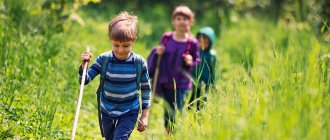Summer is a great holiday time for adults and children. Getting away from the city noise and smog, it’s so wonderful to hold various events in the forest. For children, any trip to the forest in the summer turns into an exciting adventure, full of riddles and secrets. There are so many interesting and unknown things around, and children’s curiosity takes over. If you do not follow the rules of behavior in the forest, such a trip can turn tragic for children. There are a number of rules and regulations that children must strictly follow to stay safe.
Preparing for outdoor recreation
If you plan to spend time in nature, you should prepare for this pastime in advance.
- It is recommended to choose clothing that will tightly cover your neck, arms and legs from dangerous insects and animals such as ticks, ants and snakes.
- Care should be taken to purchase a headdress made of thick fabric.
- It is better not to wear a scarf, as it can get caught on branches of trees or bushes.
- The importance of communication devices should not be underestimated. It is advisable for a person going to nature to take a mobile phone with him. The vacationer should also have matches, a knife and a watch.
- You can use an insect repellent, especially if the vacationer plans to stay in an open area or in a tent for a long time.
- If a vacationer plans to have a picnic, then he needs to take care of purchasing garbage containers in advance. All waste left over after eating must be placed in bags or special containers and thrown away in designated areas.
Basic rules of behavior in nature
- It is not recommended to stay in nature until dark.
- You should not leave the paths and trails.
- If a person realizes that he is lost, he should listen to the surrounding sounds. The noise of cars or the barking of a dog can help you find directions to the nearest town.
- You should not rest near anthills, wasp nests and other dangerous objects. Before setting up your tent, you need to carefully inspect the surrounding area.
- You should not pick unfamiliar berries and mushrooms, as they can be poisonous.
- It is not recommended to drink water from reservoirs, as there is a high probability that it is unsuitable for drinking.
- It is important to avoid using devices that play loud music as it may disturb animals. Sharp unnatural sounds frighten animals, making them irritable and aggressive.
- Avoid using eau de parfum or perfume as strong odors may attract insects.
Summer and early autumn are the best times for walking with your baby in nature. Not just in the nearest public garden or with a stroller on the embankment, but when going out of town, with the whole family or a large company with preschoolers and parents. Yes, such an event requires special preparation, but your child’s amazing memories and impressions of real wild nature, with forest flowers and smells, streams and glades, are worth the time and effort.
If your entire family is experienced hikers, then your child will naturally learn the correct ways to behave in the forest. Such parents also take their babies with them, of course, for a short time, without an overnight stay, and with the opportunity to return home by car.
If you rarely go out into nature, take your children on short walks first, no more than 2-3 hours. Before the trip, you should prepare your child, tell him about the forest, you can read fairy tales that contain forest adventures. This will make it easier to keep your child occupied while traveling. Dream with him what he will do in the forest. Children should learn in advance what is not allowed in nature.
Rules for child behavior in the forest with pictures
1) Make fires and try to make fire. Terrible forest fires are the work of human hands;
2) Leave trash, even bury it. You need to take bags and take food waste, plastic bottles, etc. with you to the nearest populated area;
3) Try unfamiliar berries and mushrooms (you can get poisoned), pick flowers (they will wither in half an hour), break the stems of plants with your hands (some can be poisonous or cause allergies);
4) Move away from the path and from people, hide from those with whom you came into the forest, leave a person alone in the forest, especially other children;
5) Screaming loudly unnecessarily;
6) Turn on your cell phone during a thunderstorm;
7) Destroy nature - destroy bird nests, burrows of small animals, anthills, wasp nests, break living tree branches, trample and kick mushrooms;
 Touch animals and especially take them out of the forest. An animal or bird, if it allows itself to be caught, may be sick, and this is dangerous.
Touch animals and especially take them out of the forest. An animal or bird, if it allows itself to be caught, may be sick, and this is dangerous.
Or these are cubs, and somewhere nearby is their parent - a large bird, a predatory animal capable of attacking to protect the offspring.
There are also animals - beggars, emboldened squirrels and gophers running near the tourist trails, impudently demanding treats. Don't hand feed! Place the treat on the ground.
What to do on a walk in the forest with a child? You can talk with your little why all the way, talking about plants, animals, and seasons. You can take an old camera and let yourself take pictures. You can go on a hike with your fidget, let him climb a mountain or hang on a large strong tree branch, collect pine and spruce cones and dry branches for winter crafts. By the river you can collect flat pebbles for appliqués or home painting. In the clearing you can play catch, catch, and other outdoor games (except hide and seek) with your children.
How to prepare for a forest walk with a preschooler
- Prepare clothing that fits snugly around your wrists and ankles. This is protection against ticks and mosquitoes. Pre-treat clothes with insect repellent spray outside an hour before the trip and dry them. Hats for yourself and your child;
- Bring children extra underwear, socks, T-shirts, shoes;
- Charge your camera and phone, top up your balance;
- First aid kit: bandage, cotton wool, plaster, iodine, remedies for mosquito bites, motion sickness, painkillers, wet wipes, antiseptic gel. Baby diapers;
- Food. Tea in a thermos, sandwiches, cookies, boiled eggs, vegetables and fruits (wash, dry, wrap in advance). Bottled water. Place food in containers with lids;
- Disposable tableware, tablecloth, garbage bags with handles. Toilet paper;
- A camping knife, a flashlight, batteries, a mat, one small toy for a child. If you go in the car - a blanket;
During the first few trips, overnight stays are excluded. You need to leave the forest with children a couple of hours before dark. Have a nice walk!
What should a child know before going outdoors?
Children's favorite way to get to know the world around them is to put everything they can get their hands on into their mouths. Therefore, wildlife objects can cause danger. It is worth explaining to the little ones that they cannot try the berries they encounter without showing them to adults. The same applies to other gifts of nature.
Older children should be taught how to move around the forest correctly: you shouldn’t rush around headlong, because if you trip over a random stone or root you can be seriously injured.
The main dos and don'ts
| Can be done with adults | Can't do |
| Approach bodies of water | Run away from adults |
| Play in the water | Go far into the forest |
| Approach an open fire | Throw garbage |
| Collect bouquets | Aimlessly pick flowers and grass |
| Collect berries and nuts | Try raw mushrooms, unfamiliar fruits |
| Look at anthills | Pick up fauna representatives |
It is useful to explain to children that all living beings have the right to live and grow. Therefore, you cannot kill insects, spoil berry bushes and mushrooms, even poisonous ones. Every plant and animal is an important part of the ecosystem; deprivation of one representative of flora or fauna can negatively affect nature.
When in the forest with a child, take care of his safety:
- the baby should not be in the sun for too long;
- clothes should be as bright as possible so that the child can be clearly seen.
Pack and take a small first aid kit with you, because a young city dweller who is not accustomed to insects and plants may get hurt or react too sensitively to pollen.
A portable first aid kit should contain:
- hydrogen peroxide;
- brilliant green or iodine;
- Activated carbon;
- burn remedy;
- antihistamine;
- repellent and remedy for mosquito and bumblebee bites;
- antibacterial wet wipes.
After finishing an amazing forest adventure, remind your child that all garbage must be collected and taken with them, and the fire must be extinguished to prevent a forest fire.
It is necessary to follow simple rules of behavior in nature; for children, following them will be a guarantor of safety, will help them learn a caring attitude towards living beings, vision and understanding of beauty, and will instill in children a love for their native land.
Rules in nature - reminder
| Season | It is forbidden |
| Spring | · pick primroses; · destroy birds' nests; · burn out last year's grass. |
| Summer | · tear off webs and kill spiders; · try to catch butterflies, bees, dragonflies; · pick berries and mushrooms that you were not familiar with before. |
| Autumn | · set fire to dry leaves and grass; · pick mushrooms. |
| Winter | · touch and break fragile branches; · scare forest inhabitants. |
| In any season | · damage the bark of trees; · leave fires unextinguished; · make noise; · break shoots of bushes and tree branches; · catch animals, birds, take them home; · leave trash. |
How to behave in nature: 10 mandatory rules
Illustrative photo: pexels.com Summer is the time for vacations, travel and weekend picnics. It is worth preparing for outdoor recreation and it is advisable to know how to behave so as not to harm the environment. We talk about the mandatory rules that must be followed when going out of town.
1. Keep quiet
The main thing in nature is not to be selfish. You have come to the mountains, a protected place, to a reservoir where various birds, animals, and fish live. Do not invade their territory by shouting or scare the local inhabitants.
2. Don't harm trees
Many people have known since childhood that trees are “the lungs of our planet.” They create oxygen from carbon dioxide, which is necessary for the life of all living things. Do not break them, do not pick off the leaves, do not rip off the bark. This can make them vulnerable to parasites and pests and lead to death. Don’t forget that you are in a territory that has its own “laws”. This is a living place. Behave correctly, do not destroy nature.
Illustrative photo: pixabay.com
3. Put out the fire
Make sure you have completely extinguished the fire. This is a mandatory rule. Fires due to human negligence sometimes reach enormous destructive proportions. There are many examples of this.
4. Don't litter
Don't leave trash. Do you really like to relax in a place where someone didn’t bother to clean up after themselves? Cleanliness begins with each of us. For example, paper left behind can cause a fire by igniting in the bright sun. Cellophane and plastic take hundreds of years to decompose, which pollutes our planet. Let's support the eco-project #jasylbolsyn, travel consciously and together preserve the beauty of Kazakhstan's nature.
5. Don't pick flowers
Flowers are also alive, but if you pick them, you kill them. It's better to just enjoy their smell. Let them continue to grow in our steppes, fields and meadows. If this does not stop you, then remember that some plants are included in the Red Book. Their destruction faces a multi-million dollar fine.
Illustrative photo: pixabay.com
6. Save medicinal herbs
When collecting such herbs, do not pick a lot in one place. Leave a few plants so they can reproduce.
7. Don’t destroy anthills
You can't destroy anthills. These insects are very important to the ecosystem.
8. Don't touch birds' nests
If you see a nest, don’t touch it, don’t touch the eggs or chicks. A parent will definitely smell someone else’s scent and may abandon their children to certain death.
Illustrative photo: pexels.com
9. Leave butterflies and beetles alone
Many people like to catch butterflies and trample beetles. But it's better not to touch them. Think about it, maybe these are representatives of an endangered species.
10. Don't trample the grass
Small animals can live in the grass. If possible, use the existing path.
When planning your trip, remember that you can always buy profitable plane or train tickets on the Aviata.kz website or app. The search will only take 2 minutes. By purchasing tickets in the application, you accumulate bonuses.
Original article: https://www.nur.kz/leisure/tourist-routes/1926987-kak-vesti-sebya-na-prirode-10-obyazatelnyh-pravil/
Movement
It is imperative to look at your feet. And not only so as not to trample mushrooms and flowers, but also so as not to fall off the slope, not to step on a snake, etc. If there are paths in the area you need to walk through, then it is best to follow them. If a large group of vacationers has gathered in a clearing, it is better to disperse so as not to disturb the vegetation cover.
To avoid damaging lichen and moss, it is better to move on them when they are wet. You cannot go straight down the slopes. Ideally, you need to move at low speed and in zigzags.
Camp setup
There are certain rules of behavior in nature for pitching tents and bivouacs. They need to be installed in a safe and open place, but not in clearings with moss. If you plan to plant them near water, it is better to do this outside the water protection zone. Dead wood is used for tent poles. Or you can take the stands with you, as well as pegs for fastening to the ground.
For toilets and food waste, you need to dig a hole, but no closer than 50 m from the reservoir. When leaving, you should bury it, or cover it with removed turf, and all debris should be burned. What will not burn, take it with you (products made of plastic, iron and glass).
Rules of conduct on the river
Swimming is a favorite activity for children, but cool river water can be dangerous. It is important to know the rules, which in Russia have not changed much since the 19th century. Rules of behavior for children on the water:
- You should not dive in unfamiliar places.
- Do not play dangerous games with capture.
- In winter and spring, do not go on the ice.
- If you don’t know how to swim, use armbands or an inflatable ring.
- You cannot drink water from the pond.
- Don't swim too far. Unless you are a strong swimmer, avoid long distance throws. This could end badly.
- Do not enter the water while intoxicated. Especially in the heat. Low water temperature and high air temperature will cause temperature shock. This is fraught with consequences.
- Pay attention to special signs and pointers describing the rules of behavior in nature; the pictures depicted on them will help you find your way.
- If there is a sign indicating that swimming is prohibited, do not take risks.
- Having discovered a previously unfamiliar body of water, try to analyze whether it is suitable for swimming. Muddy water, strange snags, lack of flow and stagnant water are bad signs. Good – no thickets nearby, running water at an acceptable temperature.
What are the rules of behavior in nature for children near water:
- Don't let children go too deep;
- Check the water temperature; children should not be in water with a temperature below 26 degrees;
- Acceptable residence time is up to 10 minutes. In warmer water – from 20;
- Do not allow your child to swallow water. Explain that this is dangerous;
- Provide your child with safety devices. Teach basic swimming skills so that your baby can stay on the surface.
What water safety signs look like
In preschool institutions, educators carry out explanatory work on the safety of children on the water. These include conversations and lectures; it could be a presentation where water safety signs will be placed on the slides. Of course, not everyone at this age can read, but they are all able to remember the designation of these signs and their meaning.
For your information! The most important sign is the one framed in green. It depicts a man swimming. This is how swimming places are designated.
The same green frame depicts two kids standing in the water. This sign identifies swimming areas.
An identical frame depicts a swimming dog. This is a place for animals to bathe.
Signs you need to know
A swimming man is depicted in a red frame against a background of blue water. The frame is crossed out diagonally in red. Swimming is prohibited here.
These are the basic water safety signs that a preschool child should know.
Animals and birds
Wild animals should not be fed. The foods that humans eat are not always safe for animals and birds. You can't destroy anthills. Many ants are listed in the Red Book.
Rules of behavior in nature prohibit picking up and touching baby animals and chicks. Eggs in nests should not be touched. After this, their parents abandon them and they die. It is also prohibited to take wild animals and birds into a populated area. It is not recommended to take dogs with you on vacation at a time when wild animals are raising offspring. In addition, they will not protect you from meeting a bear, and by barking at the animal, they can anger it and lead it to its owners.
Rules of behavior in the forest for children (memo)
If you are planning to go hiking, then it’s time to learn the rules of behavior in the forest for children. While walking, you need to remember about preserving nature and, of course, your own safety. To protect yourself from ticks and other insects, it is advisable to wear a hat or panama hat, a jacket or sweater with long sleeves, thick pants, they should be tucked into your shoes, it is better to put on rubber boots. You also need to use special creams and ointments for insect bites. Be sure to have a supply of water with you, at least for a day. Don't forget about personal hygiene products.
Safe behavior in the forest
You need to remember how to behave in the forest.
To ensure that communication with nature leaves only good memories, let’s consider the basic rules that help avoid dangerous unforeseen situations:
- do not go into the forest alone, only with adults;
- take a phone with you to contact relatives;
- you need to return from the forest before dark;
- do not go deep into the forest;
- You should not enter the forest by vehicle, this will harm the vegetation;
- It is forbidden to light a fire without adults, because fire is dangerous both for humans and for the inhabitants of the forest, it is very difficult to stop its spread;
- Do not burn dried grass or leaves;
- do not throw garbage, you cannot pollute nature, this is a home for animals and birds;
- do not break the glass, you will injure yourself and harm the inhabitants of the forest;
- You cannot make noise in the forest: shout, listen to loud music, such behavior causes anxiety among forest inhabitants;
- do not offend wild animals, they are dangerous in an angry state, if there is a danger of attack, do not show fear and do not stand with your back, it is better to slowly stand and wait for the animal to leave;
- You should not take away baby animals, they can be carriers of very dangerous diseases;
- do not touch the nests of birds, chicks, eggs, because the birds may be in danger, you may attract the attention of predators, also never take the chicks with you, they will not be able to survive in captivity;
- do not destroy anthills, ants are the orderlies of the forest, their work brings great benefits;
- do not catch bumblebees, butterflies, dragonflies, ladybugs, they pollinate plants and destroy pests; by destroying them, you will endanger nature;
- do not catch frogs and tadpoles;
- do not kill spiders, do not tear webs;
- Walk in the forest only along paths, do not trample vegetation and soil, because herbs and many insects may be damaged;
- do not break branches of bushes and trees, do not make memorial inscriptions on them, do not tear off the bark, do not collect sap from birch trees (if you do not have the necessary skills), take care of them, do not harm them;
- do not pluck flowers, especially from the roots, because they will not grow again, among them there may be rare ones listed in the Red Book; forest flowers should delight with their beauty, and not wither in bouquets;
- It is allowed to collect familiar medicinal herbs, berries, and nuts if there are many of them in the forest;
- never taste unfamiliar berries, plants and mushrooms, there is a high probability that they are poisonous;
- You can collect edible mushrooms only under the supervision of adults, never tear them out, use a knife so as not to damage the mycelium;
- Do not trample inedible mushrooms, because they are food for animals. Remember, proper behavior in the forest is the key to your safety.
What to do if you get lost in the forest
So, the basic rules on how to behave in the forest if you get lost. In this situation, you should not give in to panic and run without looking back. You need to calm down, stay in the same place and call for help. You weren’t found, which means it’s time to call your relatives and friends; if there is no connection, then you should dial the emergency number - 112, it is always available. Tell us about your surroundings and they will tell you how to get out of the forest. Rules of behavior in the forest for schoolchildren imply knowledge of parts of the world. At noon, stand with your back to the sun, your shadow will point north, east will be on your right hand, and west will be on your left. Follow the instructions of the emergency services specialist.
If you don’t have a phone, then listen to the sounds around you, hearing human voices, the sound of cars or other signs of civilization, go in that direction. If there are no such sounds, then you should find a stream, it will definitely lead to a river; if there is a river, it means there will be people nearby. Along the route, leave notches on the trees or break branches, this will indicate your direction to the rescuers and will help you if you walk in a circle. Nature changes, so you shouldn't rely on the location of moss and anthills. Try to remember which side you entered the forest from, in which direction you were moving. Look around, if you see power lines, follow them.
If you couldn't get out of the forest and it's getting dark, get ready to spend the night. You need to make a hut from branches, make a small fire (taking precautions), and go to sleep near the fire. Think only about the good, a new day will come, and they will definitely find you.
Rules of behavior in the forest
www.rastut-goda.ru
Fire safety in the forest
The forest is a fire hazard
Rules:
- Fire is one of the biggest dangers in the forest, so young children should not make a fire without an adult.
- You can't play with fire.
- If a fire does happen, it is important to run away from the forest in the direction from which the wind is blowing.
- Be sure to inform an adult about the fire.
For your information! Parents should surround the child with care and attention so as not to leave them alone, and children would not want to play with fire. Safety in the forest for children depends entirely on the behavior of adults.
Where to light a fire outdoors?
To avoid causing a fire, light a fire in an open space, away from trees and bushes.
Put out the fire
Mandatory rule in nature! Make sure you completely extinguish the fire. You can’t even imagine how many forests are dying from fires because a fire is left unextinguished.
Reminder of rules of behavior in the forest for children in pictures
Slides and text of this presentation
Children must remember and understand: Birds’ nests must not be destroyed! If you saw an egg in the grass or heard the cries of chicks, do not approach, do not climb there and do not disturb either the birds or the nest.
Ants are forest orderlies; It’s not for nothing that people called them that! So that the forest is beautiful and healthy, Without harmful larvae and beetles, Ants are on guard day and night: They drive various bark beetles away!
Just don’t bother them, my friend! Don't destroy anthills! These orderlies are so needed for the forests of your native country!
For hedgehogs and squirrels, the Forest is their home. They live there boldly, both in summer and winter:
Therefore, you should not take them to the city... Believe me: they are in captivity They will not eat or sleep...
They find food to raise their children and don’t want to leave the forest at all...
Moths fly in the forest, boogers and beetles crawl... Mother Nature gave them life. They all have their own things to do.
You will see them on the way - Don’t offend, but move away! Without insects, the forest, my friend, is lonely and empty...
Flowers decorate meadows and forests. But this is not only the beauty of nature. Bees find a healing gift in them, And butterflies drink sweet nectar from them. There is no need, friends, there is no point in tearing them, There is no need to make bouquets out of them... The bouquets will wither... The flowers will die... And there will no longer be such beauty!
There are rare flowers, White and tender: Lilies of the valley, snowdrops will nod to you warmly...
Just don’t tear them up - with them the forest is kinder, brighter. After all, now there are very few such flowers on earth...
A colored butterfly flutters above you... The dragonfly frolics, dances, has fun...
Everyone is so excited about summer! There is no need to catch them... Let them fly and decorate the Earth...
The forest has its own music... Listen to it, friends! Here are the trills of birds, Here is a squirrel jumping up and down, And here is a grasshopper chattering, A woodpecker is knocking on a branch...
So many sounds here and there! There is no need for noise and hubbub in the forest: You can’t make noise, shout, shout, or play loud music!
It is dangerous to have fun with fire without adults - the fun can end horribly. Sometimes it can be very dry in the forest. A fire will turn into a serious disaster! Imagine that the flame will easily flare up, will begin to blaze, scatter and sparkle - It will be impossible to extinguish it then... Forest fires are a big problem!
You guys have come for a hike... Of course, you need to rest: Play and frolic, And eat and drink... But there are still banks, Cellophane, pieces of iron, bottles around...
You can't leave them here! Let's not be lazy, friends: The garbage here in the forest is alien, Let's take it with us!
You can’t throw glass in the forest, You can’t break bottles; Sharp fragments are dangerous - you will cut yourself terribly on them!
And if you suddenly fall on them, you could end up in the hospital! And the forest inhabitants don’t need Glasses either...
The trees stand like giants. The hooligans don’t spare them And they cut them with sharp knives. The words on the tree are “as a keepsake!”
But it’s such a cruel thing to do! You can't harm trees. Let them grow in the forest - bring goodness and beauty...
If you are going to pick mushrooms, take a sharp knife with you; Carefully cut off the mushroom with them - leave the mycelium in the ground.
And if you come across strawberries, a lingonberry or blueberry bush, gently pick the berries, but leave the bush, take care of it.
There are a lot of different mushrooms in the forest... Don't touch the inedible ones! Don’t put them in a basket, But don’t knock them down either... Forest animals need them: Foxes, hedgehogs, hares...
Only people don’t eat them: There’s poison in toadstools and fly agarics! But for forest animals, that mushroom is still useful and good.
Don’t offend the snake And when you see it, don’t grab the stick, Don’t wave your arms, don’t shout - Just step away and be quiet...
Although snakes are dangerous, they are necessary: They must preserve cleanliness; Don’t do harm or harm to the forest and water orderlies...
With the onset of the summer season, many people begin to go to the forest to pick mushrooms and berries. Very often, during such walks, parents are accompanied by children who, due to a certain lack of awareness, do not understand how to behave correctly in the forest. Improper behavior in a forest can cause an emergency, such as a fire.
In addition, a child can get lost and get lost, so before you go on such a walk with him, you should definitely give an introductory briefing on the topic “rules of behavior in the forest for children in the summer.”
A reminder about the rules of safe behavior in the forest for children
To ensure that a dangerous situation does not arise as a result of visiting a forest area, the child must follow certain rules, namely:
- Children of any age should go to the forest exclusively with adults. Independent walks through the forest area are not permitted under any circumstances.
- While in the forest, you should not go deep into the thicket. It is imperative to keep a trail or other landmarks in sight - a railroad, a gas pipeline, a high-voltage power line, a road for cars, and so on.
- You should always have a compass, a bottle of water, a mobile phone with sufficient battery power, a knife, matches and a minimum set of food items with you.
- Before entering a forest, you should definitely look at the compass to know which side of the world you are entering from. If this device is in the hands of a child, parents should make sure that he knows how to use it.
- If a child falls behind the adults accompanying him and gets lost, he should remain in place and scream as loudly as possible. At the same time, during the walk itself, you should behave as quietly as possible, so that if danger arises, no one doubts what exactly happened.
- While in the forest, you should not throw any burning objects on the ground. In the event of a fire, you should run away from the forest area as quickly as possible, trying to move in the direction from which the wind is blowing.
- Finally, children should not put any unfamiliar berries or mushrooms in their mouths.
All these recommendations must be conveyed to the child from a very early age. Remember that the forest is a place of increased danger, in which it is very easy to get lost, but at the same time very difficult to get out. While in the forest with your son or daughter, try not to take your eyes off him, and if the offspring disappears from your field of vision, immediately call him in a loud voice.
Copying information is permitted only with a direct and indexed link to the source
the best materials from WomanAdvice
Subscribe to receive the best articles on Facebook
kleotur.info
Responsibility for non-compliance with the rules of behavior in nature
There is a fairly simple law at work here. It states that ignorance is no excuse. Thus, everyone is personally responsible, even if they did not know how to behave in nature. There is a fine for some actions. Illegal poaching, for example, is criminalized. The penalty is a fine of 500,000 rubles, or two years in prison. The same punishment applies for illegal logging.
A better way to get acquainted with the rules of behavior in nature are pictures that contain a fairly general picture for all types of violations. From the video you will learn what you need to take with you into nature so as not to disturb the fragile ecosystem.
Sources
https://nsovetnik.ru/pravila_povedeniya/kakovy_pravila_bezopasnogo_povedeniya_na_prirode/ https://www.rastut-goda.ru/family-council/8472-pravila-povedeniya-na-prirode-dlya-detej.html https://BusinessMan.ru /new-pravila-povedeniya-na-prirode.html https://vospitanie.guru/povedenie/pravila-na-prirode-dlya-doshkolnikov https://storyofmylife.ru/kak-vesti-sebya-na-prirode/ https ://nowifi.ru/vyzhivanie-v-dikoy-prirode/kostry/104-pravila-povedeniya-na-prirode.html
Safety rules in nature







